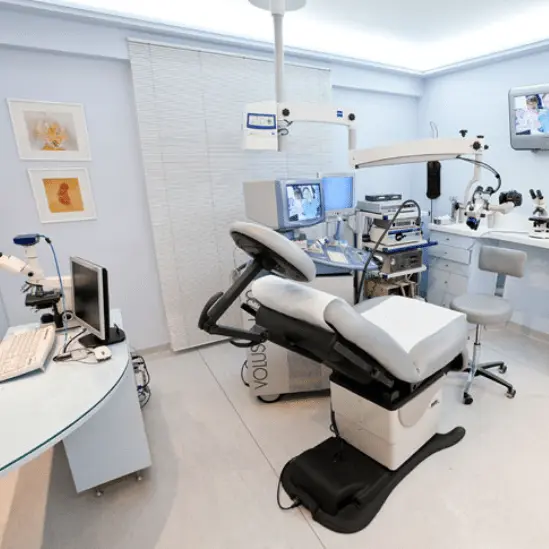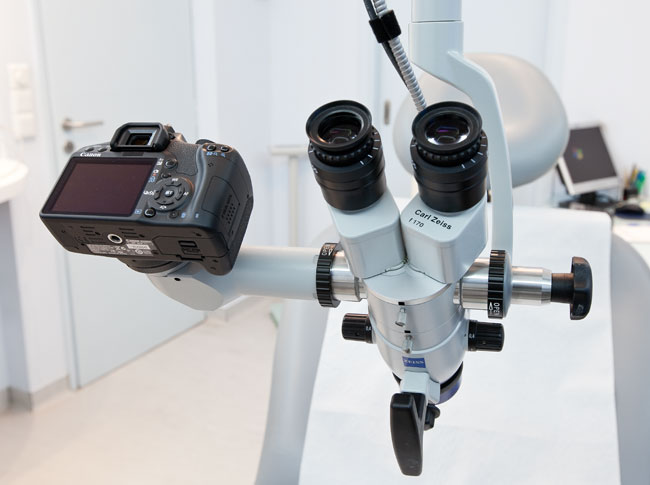
Alexandros E. Mortakis
Gynaecological Surgeon Doctor of the University of Athens
Specialization in:
∙ HPV related diseases
∙ Vulvovaginal diseases
∙ Colposcopy, Hysteroscopy, Laparoscopy
∙ Laser surgery
∙ Endoscopic surgery
A woman who is properly informed and screened lowers her risks
Find out about:
Our answers to your most frequently asked questions about HPV Diseases
- HPV and cancer
- HPV Diagnosis
- HPV Transmission
- CIN, LSIL,HSIL
- HPV Treatment
Of the 100 different HPV genotypes discovered to date, approximately 30 infect the epithelia of the skin and mucous membranes of the lower genital tract and anal region. These 30 HPVs are known as genital types.
Read moreIt is a test that tells us if there are oncogenic HPVs in the cells of your cervix, in such a quantity (viral load) that they are causing an infection.
The HPV test is used to prevent cervical cancer.
It has been shown that cervical carcinogenesis usually begins after persistent or recurrent infection with oncogenic HPV. This infection is detected by the HPV test.
Read moreIn any such case, the patient should consult her gynecologist. He is able to assess what is the next diagnostic step for his patient. If, for example, the Pap test indicates simple inflammation (cervicitis) caused by microbial agents, he is likely to recommend a search for the microbes by taking cultures and then proceed with treatment. However, if the Pap test reports “cells with HPV infection”, “atypical cells”, “precancerous or cancerous cells” or various special categories referred to internationally as LSIL, HSIL, ASCUS, AGUS etc., then your doctor will recommend colposcopy and other more specialised tests.
Read moreThe acronym CIN comes from the words Cervical Intraepithelial Neoplasia, which stands for Cervical Intraepithelial Neoplasia.
The name CIN in itself means that dysplastic cells that do not have the typical normal morphology (that is why they are called atypical) are restricted to the epithelium only (intraepithelial neoplasia).
The lightest lesions are those designated by the term CIN1. In these lesions only the lower third of the epithelium (1/3) is occupied by cells with inflammatory atypia. CIN1 lesions are caused by both low-risk HPV and oncogenic HPV.
Read moreIt usually has no symptoms. Most people who are infected don’t know it, precisely because they have had no symptoms.
Of those who are infected, only a few will show lesions that can be seen with the naked eye. The obvious lesions are: acute warts, a number of precancerous lesions of the vulva and infiltrative cancers.
Read moreThe main aim of the Pap test is to prevent cervical cancer. We are primarily interested in detecting atypical cells.
Often during the examination under the microscope can be diagnosed inflammations from microbes, fungi, trichomonas. These findings simply help your doctor to prescribe treatment if he or she deems it appropriate.
Also in menopausal women it is often described in the test result that there are changes of atrophy of the epithelium. This is due to the drop in estrogen levels during menopause.
Read moreNot always. Most of the time, especially in young women, it is a simple infection. However, there are several cases in which subsequent testing reveals precancerous lesions.
Read moreColposcopy is recommended in the following cases:
- If suspicious cells are found on the Pap test.
- If the HPV test is positive (which means that there is an oncogenic HPV infection).
- When the doctor sees something suspicious in the simple examination.
- Before operations on the lower genital tract, to assess the extent of the lesions.
The acetic acid solution used in colposcopy causes a slight stinging sensation that quickly subsides.
Cervical biopsies are done with special forceps and do not hurt. The discomfort felt by patients is mild and no painkiller is needed.
Read moreYou are more likely to get HPV with:
- Vaginal intercourse without a condom
- Anal intercourse without a condom
Different types of genital HPV can remain in our bodies for weeks, months or even years after the initial infection. The lesions caused by HPV are usually transient subclinical infections. The term “subclinical” means that they are not visible to the naked eye. Only acute warts are visible. Subclinical lesions persist for months or even years on the skin and mucous membranes of the genital and perianal area. They recede when our immune system has managed to suppress the virus. They reappear if our immune system is weakened at some point in our lives (due to stress, taking certain medicines, etc.).
Read moreHPVs are selective. They only infect the epithelium of the skin and certain mucous membranes. As we know, the skin covers the outside of our body, while mucous membranes cover internal cavities such as the mouth and vagina. The surface of the skin and mucous membranes is covered by epithelium.
Read moreWarts are lesions caused by HPV.
Lesions occur if your immune system allows it. But the amount of viruses transmitted (viral load) and the type of HPV also matters. 90% of warts are due to types 6 and 11. But in a small percentage, oncogenic HPVs (such as HPV16) are detected.
It is good to know what your chances are of getting it and how to protect yourself.
Read moreIn a monogamous relationship, the diagnosis of HPV infection usually causes problems in the couple’s relationship. Once one of the two is diagnosed with the infection the other is concerned about the possibility of a third party.
But finding HPV infection in someone simply means that they were infected at some stage in their life. No one can know exactly when or by whom. Nor can anyone know who infected whom (except in the case where one of the two had no previous sex life).
Read moreThis group includes ASCUS and ASC-H. Atypia is found in some squamous epithelial cells, but its severity and severity cannot be accurately determined. If a positive ASCUS result is given, lighter lesions are suspected, whereas classification of the test as ASC-H means that the presence of a more severe lesion cannot be excluded.
This term means cells with low-grade lesions. They are found in 3%-5% of Pap tests in people over 30 years of age but in much higher percentages if we focus on younger ages. If we check by colposcopy and biopsy all women whose tests showed LSIL, we find that the final diagnosis is HSIL in about 10% of them.
Read moreIn the general population we find this result in tests in small percentages (0.3-0.8%). In further testing (colposcopy), which should definitely be done in this category, usually high grade lesions are found. In a few cases the final diagnosis is LSIL (usually involving cases that were overestimated on cytological examination). However, there are also a few cases in which the test showed HSIL and after testing, the final diagnosis is invasive cancer (1-4%). Special care is required in women older than 30 years of age when HSIL is present on the Pap test.
Read moreAtypia from glandular cells, which cannot be accurately identified in the Pap test, is found in 0.2-0.8% of the general population. In 50-70% of these cases, the final test will prove that there is no problem and it was a simple overestimation. However, in the majority of the remaining women, further testing will show in order of frequency: HSIL, adenocarcinoma in situ (non-metastatic) and invasive cancer (in a few cases). The older the age, the higher the risk. There are cases (usually involving women older than 35 years) in which the doctor will ask to check the endometrium, in addition to the cervix, for fear of endometrial adenocarcinoma.
Read moreThe metaplastic epithelium is very important because it is the breeding ground for HPV proliferation. The process of metaplasia requires multiple cell divisions and makes it easier for the virus to multiply itself. It also makes it easier for the virus to exploit the metaplastic cell transformation process and, after persistent infection, to cause malignant outgrowth (this applies only to high-risk HPV).
Read moreFirst of all, it should be clarified that treatment for HPV is not causal. There is no drug that can rid our body of the virus. The so-called cure is the removal or destruction of the tissue that has lesions. The virus remains in the epithelia of the genital tract for a long time or even forever. This is not a concern even in cases of dangerous HPV. Recurrences of the lesions are few and if patients are monitored there is no risk. In those cases where the immune system prevails and the infection resolves on its own, we rarely have recurrences. In other patients, where we feel it is appropriate to intervene and destroy or remove the lesions (acute warts or precancerous), we again wait for the immune system to prevail. After the lesions disappear, it has less viral load to deal with and it is easier to suppress the HPV that remain.
Read moreStudies show that in most women infected in the cervix, HPV DNA is no longer detectable after 2-3 years.
However, there are cases where the virus becomes active again, many years later, and causes infection again.
Obviously the virus has remained in their cells all these years. We cannot know in which cases such a scenario will occur. For this reason, all women should be screened at regular intervals.
Read moreIn most people (80-90%) infected with some type of HPV, a search for viral DNA in the surface cells of the epithelium will show negative results after 2 years. It is estimated that in 60-70% of infected individuals HPV is suppressed within the first year. This is considered a healthy immune system response. Only in a small percentage of infected women, persistent and recurrent lesions in the cervical cells are seen. High-risk HPV infection appears to be more difficult to suppress, particularly HPV 16 and 18 infection.
Read moreWhat does LEEP stand for?
The acronym LEEP is derived from the initials Loop Electrosurgical Excision Procedure, which stands for Loop Electrosurgical Excision Procedure.
This procedure is also referred to by the acronym LLETZ from the initials Large Loop Excision of the Transformation Zone.
The so-called “loop” bracket consists of a thin wire through which a high frequency electric current is passed. Thanks to the passage of the current, the wire bracket cuts through the tissue and removes it.
Read moreSeveral patients with acute warts (which are usually benign) go to the doctor alarmed to see that new warts keep appearing. What does this mean? Quite simply, that we have not yet reached a phase of balancing the virulent action of HPV by our immune system. The doctor will give advice to improve immune function (stop smoking, avoid stress, good nutrition, enough sleep, etc.) and will investigate whether the body’s defences are lagging for some reasons (e.g. taking cortisone, immunosuppressive drugs, abnormal sugar metabolism, positive antibodies for HIV, hepatitis, etc.). It will also look for possible coexisting local inflammation (vaginitis, cervicitis, etc.), which “occupy” our immune system and thus, may not be effective. There are quite a few cases in which stopping smoking and treating a coexisting vaginitis is enough to recover the immune system and stop new lesions from appearing.
Read moreΣεμινάρια για γιατρούς

Written by Alexandros Mortakis
Good news about Women & HPV:
Prevention of infection & its complications
Prevention of infection & its complications
This book is written for doctors who are not experts in the field of HPV infection. It is also a patient information guide.

Clinic Services
Laser applications
Taking biopsies
Other Examinations
Preventive control
I would like to express my gratitude to my patients. This information effort would not have been possible without the countless hours of discussion with my patients, the women who have honoured me with their trust and entrusted me with their health.








